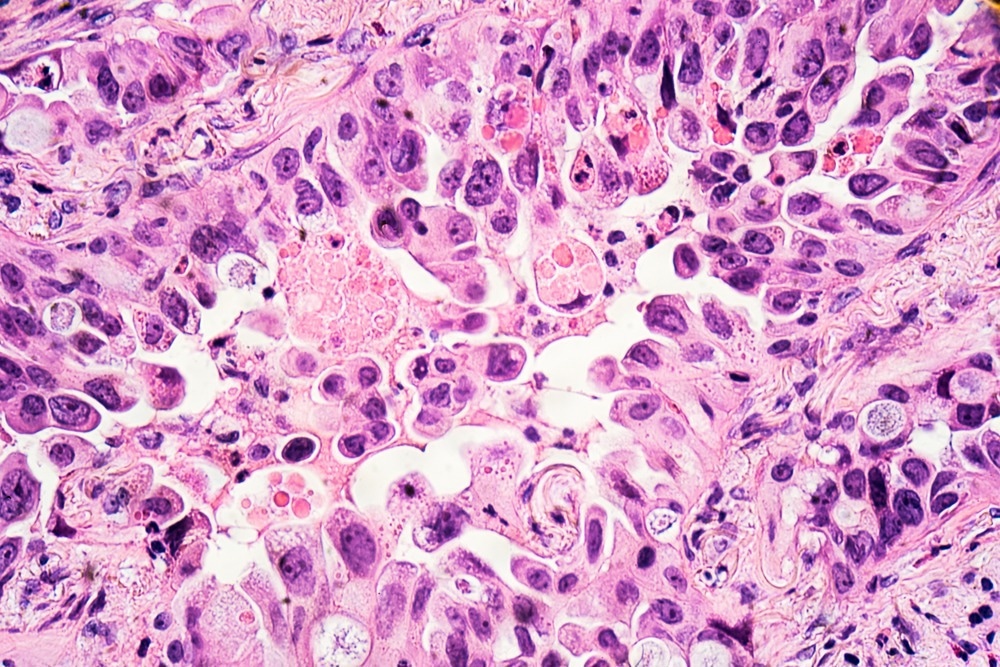Cytotoxicity is a term referring to the toxicity a substance poses to cells. It is often discussed in the pharmaceutical sector, most commonly concerning the safety of a pharmacological compound (e.g. a drug).

Image Credit: Komsan Loonprom/Shutterstock.com
Clinical trials often test for the cytotoxicity of a novel pharmaceutical drug to establish its safety profile. This informs scientists whether the drug is suitable for testing in humans or market approval.
The effects of cytotoxicity can be fatal. A cytotoxic compound causes damage to cells, sometimes death, through necrosis or apoptosis. A certain level of cytotoxicity is acceptable if studies show that the risks posed to the patient are minimal and the efficacy of the drug outweighs these risks. Often, chemotherapy drugs used to treat cancer pose a level of cytotoxicity to the patient.
For example, symptoms include nausea and vomiting, diarrhea (due to the damage caused to the intestinal mucous membranes), sores to the mouth, and difficulty eating and swallowing caused by damage to the mucous membranes of the mouth and pharynx.
Why Does Cytotoxicity Matter to Nanotechnology?
Nanoparticles are ultra-small particles of materials that measure just 1-100 nanometres in diameter. Due to their nanosize, they have unique properties compared with their bulk material counterpart, often due to their volume-to-surface area ratio.
Because of their unique properties, nanoparticles have already been widely adopted across industries to produce a number of products, including automotive and aerospace components, food packaging, construction materials, solar cells, long-life batteries, flat TV screens, electronic devices, sunscreens, toothpaste, cosmetics, and medicine. Medical applications include diagnostic tools, pharmaceuticals, regenerative medicine, surgical tools and implants.
In healthcare, nanotechnology stands to revolutionize treatment; particularly, it has the potential to provide next-generation treatments for cancer and other diseases that do not respond well to currently available therapies.
Cytotoxicity is an important topic in nanomedicine due to the quantum size effects that impact how nanoparticles interact with the body. The unique properties of nanomaterials that are desirable when designing novel therapeutics are also those that risk toxicity. Because of their size and large surface area, they easily infiltrate cells and tissues. While this can be excellent for delivering a therapy directly to a diseased area (e.g. cancerous cell), it can also lead to cytotoxicity to healthy tissues.
Before nanomedicine can reach its full potential, scientists must understand more about how nanomaterials interact with cells and their microenvironments. Clinical trials testing novel nanomedicines must test this as part of their requirements to collect safety data. As we learn more from these trials, we will be able to develop safe nanomedicines in shorter time frames with lower budgets.

Image Credit: David A Litman/Shutterstock.com
How is Cytotoxicity Detected?
Numerous cytotoxicity assays have been established that can reliability performs rapid and simple acute toxicity assessments. The following has been developed to test the toxicity of nanomaterials: transmission electron microscopy, light microscopy, hemoglobin estimation, micronucleus test, commet assay test, lactate dehydrogenase, tetrazolium salts, alamar blue, propidium iodide, neutral red assay test, capase-3 activity, acridine orange/ethidium bromide, ROS production, levels of glutathione peroxidase, catalase, superoxide dismutase, and lipid peroxidation, vitamin E.
Most often, cytotoxicity tests are performed in vitro rather than in vivo to answer questions about toxicity and dosing (which is also important to toxicity). A common model used in tests of cytotoxicity is that of in vitro sedimentation diffusion and dosimeter.
Other models include gene expression analysis, genotoxicity detection, and in vitro hemolysis. Also, microscopic and spectroscopic approaches such as atomic force microscopy (AFM), scanning electron microscopy/energy dispersive X-ray spectroscopy (SEM-EDX), video-enhanced differential interference contrast (VEDIC) microscopy, transmission electron microscopy (TEM), and fluorescence spectroscopy are used to evaluate the physicochemical structure of a cell.
What Limits Does Cytotoxicity Place on the Development of Nanomedicine?
Overcoming cytotoxicity is a big issue for nanomedicine. For it to reach its full potential, tests of cytotoxicity will have to develop to be more rapid, simple and accurate. In addition, scientists must develop ways to prevent nanoparticles from harming healthy cells and only developing toxicity to diseased cells.
Fortunately, advances have already been made in the field of reducing the cytotoxicity of certain nanoparticles that have promise in nanomedicines. In particular, scientists are focussing on developing methods that reduce the toxicity of nanoparticles that are currently used as drug carriers and in cancer treatments, such as silver (Ag), gold (Au), zinc oxide (ZnO), and titanium oxide (TiO2) nanoparticles.
Additionally, as the field of nanomedicine matures, we will accumulate knowledge on the long-term effects of nanoparticles on living systems, which is currently limited. Progression in our understanding of how nanoparticles interact with biological mechanisms will allow for rapid progress in nanomedicine and will hopefully lead to novel, effective treatments for a range of diseases.
References and Further Reading
Akcan, R. et al. (2020) “Nanotoxicity: A challenge for future medicine,” Turkish Journal of Medical Sciences, 50(4), pp. 1180–1196. Available at: https://doi.org/10.3906/sag-1912-209.
Cytotoxic drugs [online]. NICE. Available from: https://bnf.nice.org.uk/treatment-summaries/cytotoxic-drugs/
Długosz, O. et al. (2020) “Methods for reducing the toxicity of metal and metal oxide NPS as Biomedicine,” Materials, 13(2), p. 279. Available at: https://doi.org/10.3390/ma13020279
Riss T, Niles A, Moravec R, et al. Cytotoxicity Assays: In Vitro Methods to Measure Dead Cells. 2019 May 1. In: Markossian S, Grossman A, Brimacombe K, et al., editors. Assay Guidance Manual [Internet]. Bethesda (MD): Eli Lilly & Company and the National Center for Advancing Translational Sciences; 2004-. Available from: https://www.ncbi.nlm.nih.gov/books/NBK540958/
Disclaimer: The views expressed here are those of the author expressed in their private capacity and do not necessarily represent the views of AZoM.com Limited T/A AZoNetwork the owner and operator of this website. This disclaimer forms part of the Terms and conditions of use of this website.